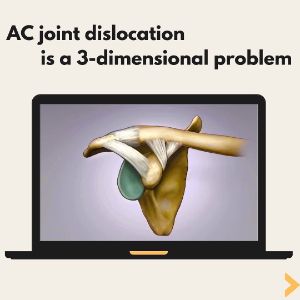AC joint separation is a complex issue that requires a thorough understanding of its three-dimensional nature in order to be effectively treated. This type of injury, often resulting from a direct blow to the shoulder or a fall onto an outstretched hand, can lead to significant pain and limited mobility if not properly addressed.
So, why is AC joint separation considered a three-dimensional problem? Steven Struhl, MD, at AC Joint Separation, breaks it down.
AC Joint Anatomy 101
First and foremost, it’s important to understand the anatomy of the AC joint. The acromioclavicular (AC) joint is where the acromion, a bony projection on the scapula, meets the clavicle, or collarbone. This joint is supported by a complex array of ligaments and tendons, which provide stability and facilitate a wide range of motion in the shoulder.
When an injury occurs, such as a fall or impact, the ligaments connecting the acromion and clavicle can become damaged or torn, leading to an AC joint separation. This separation disrupts the normal alignment and function of the joint, resulting in pain, swelling and reduced shoulder mobility.
Three-Dimensional AC Joint Injury Dynamics
Why is this issue considered three-dimensional? Traditional thinking might lead one to believe that addressing the vertical displacement of the AC joint is the primary concern. However, it is crucial to recognize that the problem extends beyond a simple vertical separation.
Vertical Concerns
The force of gravity constantly pulls the arm away from the clavicle, making it nearly impossible for a severe AC joint separation to heal on its own. Addressing only the vertical component of the injury is insufficient. A comprehensive approach is necessary to account for the multidirectional instability that accompanies AC joint separation.
Lateral Concerns
In addition to vertical movement, lateral stabilization is paramount. Neglecting the medial movement of the joint during treatment can lead to suboptimal outcomes, including a heightened risk of surgical failure. Without addressing the three-dimensional nature of AC joint separation, there’s a significant chance that the correction won’t hold up under the demands of regular shoulder movement.
The Triple Endobutton Technique
Dr. Struhl effectively treats these injuries using the closed-loop triple endobutton technique, which has emerged as a promising solution. This innovative approach comprehensively addresses the entire spectrum of issues associated with AC joint separation. By encompassing both the vertical and lateral aspects of the injury, this technique provides stable fixation that mitigates the risk of post-surgical complications and failure.
AC joint separation is undoubtedly a three-dimensional problem that necessitates a holistic treatment approach. Dr. Struhl and his team recognize the multiplanar nature of this injury and employ advanced techniques such as the closed-loop triple endo button method to provide patients with the best chance of full and normal recovery.
If you’re facing the prospect of AC joint surgery, Dr. Struhl is well-versed in the complexities of this three-dimensional problem and equipped with the expertise to address it comprehensively. Only through a thorough understanding of the multidimensional nature of AC joint separation can optimal outcomes be achieved. Contact Steven Struhl, MD – AC Joint Separation in NYC, today for more information and to schedule an exam and consultation.
Posted on behalf of Steven Struhl MD





